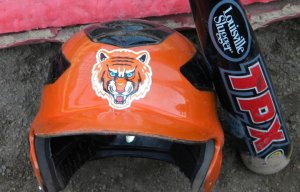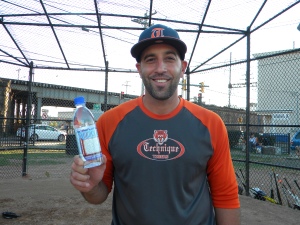Three Great Snacks for Athletes
You are what you eat, food is your fuel to perform efficiently as an athlete. Put down the chips, candy and french fries and pick up healthy snacks throughout the day to ensure you are giving your body the nutrients it needs to perform. Athletes need to understand that snacking throughout the day is crucial to their performance. Snacks keep the energy levels consistent by balancing blood sugars; ensures that nutrients are readily available for recovery of the body, especially lean muscle mass and helps to control the athletes appetite. But there’s a difference between good and bad snacks. A good snack should consist of high fiber carbohydrates, lean protein and healthy fats. Bad snacks contain empty calories, sugars and unhealthy fats. Here are three suggestions:
PEANUT BUTTER AND JELLY SANDWICH WITH NATURAL PB
This nutrient dense snack will keep you full for hours because of a hefty load of carbs and healthy fats.
CALORIES: 430
PROTEIN: 13G
CARBS: 53G
Fat: 19G
KASHI TLC PEANUT BUTTER CHEWY GRANOLA BAR
This is a great snack to have on the run, when in school, at work or in route to compete in practice or a game to help top off your energy.
CALORIES: 140
PROTEIN: 7G
CARBS: 19G
FAT: 5G
JACK LINKS TURKEY JERKY AND BANANA
This combo provides a large dose of protein and fast digesting carbs, perfect for after a practice or workout.
CALORIES: 140
PROTEIN: 16G
CARBS: 30G
FAT: 1
Handling Games
If you have coached baseball, you know how the tough the game can be. Baseball is an exciting and challenging game that is dull only to those to fail to appreciate the many possibilities that exist on each pitch. Let’s look at a couple of ways a coach can handle game situations.
First he can handle it by going to the good ol “book”. The book was developed through trial and error, when you coach this way your basically playing a percentage game. Coaching by the book will recommend using the sacrifice bunt in the later innings and playing for the big inning early in the game, playing for a tie at home and win on the road, and so on.
This type of strategy is already preplanned, well thought out in advance of the game. This strategy can be taught. It’s baseball theory and decision-making that other coaches have documented and its the safest approach to take, because if one of your decision flops you can always say “9 out of 10 coaches would have done the same thing”
Another way you can coach is by experience and instincts. Game coaching would be easy if all the situations were predictable, but it also would be extremely boring too. What makes coaching a game so interesting and challenging are the situations that are thrown at you constantly throughout a game. Situations that you may have never coached before or read about. In that case you are learning by experience daily as a coach, so when that situation occurs again you will have something to which you can base your decision. Be open to using innovative tactics when the book answer is not available or seems wrong to you. Learning on the job will make your instincts as a coach that much better. It requires instincts, training and knowledge. The best coaches have a feel as they arise, no matter what the situation! Great instincts as a coach is an asset to any team or program!!
One on One Instruction..
Parents ask me all the time. “Manny what is a good age to start pitching lessons?” This is an opinion question, some guys want the quick $ and will up sell parents to multiple lesson packages. I am 100% honest with parents, 11yrs old I usually start a kid with private pitching lesson. If a kid is younger than 11 and has very poor movements throwing the ball, I will suggest private lessons on throwing properly before pitching or like I would call it “throwing to a target” they both are the same thing BUT……
Parents should understand that pitching is a complex two phase motor skill, you have the wind-up phase then the release phase. Pitching is a continuous movement that is very complex and the naked eye will not catch all the flaws. That’s where video comes into play, video offers accurate feedback, thus increasing learning, which increases performance and minimizes risk of injury. If your son is going to an instructor and his instructor is not using some type of video during lessons, question him/her on it. Ask them WHY NOT? 13 years as an instructor and two years into it I started using some type of video, back then was a hand held camera with actual video tapes, now upgraded to iPad, iPhone, etc. etc. Without using video, instructors are simply guessing since pitching is such a complex movement that contains the fastest human motion in sports, the acceleration of the pitchers arm.
I purchased an app on my iPad called Coach’s Eye, cost me about $4! This app allows me to instantly show my athlete frame by frame slow motion footage of his pitching mechanics. I can draw lines, circle body parts, play it back, INSTANTLY!!! The modern day kid can relate to it, instant feedback is the value of your lesson. This app is great during a practice session, bullpen or lesson. Game time footage, I suggest using a camera that can zoom in from a distance to get the pitcher only.
IT’S NOT OK TO DO IT WRONG!! Doing it wrong will lead to injury. It takes about 3000 correct repetitions to get rid of a bad habit. This can take months, can take years, all depends on how focused that particular athlete is on improving his skill level. Spending 30-45 minutes with an instructor once a week, will not correct everything that is wrong. Self-discipline to attempt, execute appropriate repetitions will help close the gap to 3000 correct reps.
<
The Greatest Gift…
Glove? Bat? Evo shield? Batting Gloves? Cleats? Nice Uniforms? Fancy catcher’s gear? NO, none of the above! The greatest gift you can give your player’s is, TO BELIEVE IN THEM!! Giving your players this gift will build their confidence. Showing your players confidence will create respect, honesty and a strong relationship between player and coach. In order to be successful in building confidence, a coach must love what he does, respect his players and show IT! SHOW IT…set your ego aside and show your players that you respect them and genuinely care.
When you build confidence in your players and team, don’t destroy it. Players look at your posture and facial expression as a reflection of their performance. Keep it simple, coach with confidence in your voice and love. Athletes are very perceptive of their surroundings.
As a coach always remember, the GREATEST GIFT YOU CAN GIVE A PLAYER IS TO BELIEVE IN THEM
Offensive Skills.
At Technique we all agree that offense is not hitting!! How many times as a coach after a loss, you look at the score book to see you had more hits than your opponent? It happens very often where you will out hit an opponent and yet can’t generate offense to end up on the short end of the ball game.
Offense is the ability to score runes when your team is not hitting. How do you do that? Bat control, ability to hit and run, hit the ball to the right side, advance runners from first to third with good base running. Early in the season I preach about advancing first to third, I emphasize base running and really dwell on advancing first to third. This will let my team know that I want them to be aggressive on the bases and force the defense to execute. Having ability to run is not all you need to have a solid running game. To have a solid running game, players must have knowledge of the running game. Early in the season at Technique we cover all our phases of the running game. Throughout the season we have refresher runs to keep our players sharp, let’s face it they are going to make mistakes! That’s OK, teach when they make them mistakes, reward an aggressive mistake, criticize a mental mistake. Mental toughness is almost the entire battle in baseball.
Remember, “SPEED NEVER SLUMPS” hard 90, hard 70, had 65 whatever age group whether it’s 18U, 12U or 10U we preach hard out of the box 100% of the time. Force the defense to execute and make plays. The ability to hit and run and hit behind the runner takes work at practice during your BP sessions. It’s important that you add that to your BP regimen, rather than just get in the cage or on the field and hack away. At Technique we like to take BP (batting practice) with a purpose. Every minute in practice counts and should always be productive, CLOCK IS TICKING!!!!
Criticism, How to make it count!
Criticism! How do we handle criticism? It’s going to happen, as a coach you are going to receive and you are also going to give criticism to your players. At Technique we feel criticism is necessary, if offered in a productive manner criticism creates improvement. I have several ways to offer criticism, depends on the mental toughness of that particular player. First I will offer a positive reinforcement of something they do well, I make sure to give them a compliment before the criticism. Then reinforce that I have confidence in them to get the job done the right way. Never a false compliment, never in a phony manner, remember always speak in truth. Another way to offer criticism is to criticize first and firm, then take the sting off by a pat on the back, a “your better than that” verbal reminder. Nobody remembers the beginning, always remember the end. Make sure to walk up to your player and quietly send him a message between you and him with positive reinforcement that you are confident in his ability.
We all like to be given a pat on the back or praise for a job well done, this can also go in the other direction! A player can become weaker, if his need for praise becomes stronger. If you focus on what is the right, which is improvement then the criticism and compliments will become innate in the way you communicate with your athletes.
Criticism pointed at you as the coach! Remember you are the teacher, all eyes are on you, verbal and nonverbal actions are all up for criticism. If you focus on what you believe in, take responsibility for your actions, stay open to new ideas, turn a deaf ear to all praise/criticism then you will hear all you need to hear of both!
CLICK ON HELMUT TO VISIT US!!!
Control What you Can…..
At Technique we believe that in baseball you can only control two things:
1. Attitude
2. Throws
That’s it….
Attitude is important, players must be prepared to work hard daily with the appropriate attitude. Players that come into Technique that have been stroked by other coaches in the past and not pushed, usually do not last. The approach to preparation by all the players must have a positive attitude. One negative attitude amongst the group can make for a bad day at practice. The qualities that we are interested in as coaches at Technique are, attitude, hustle, cooperativeness, unselfishness, team player, quickness, stay aggressive, be on time and respect your teammates! These all attribute to a great attitude and players can control that. Players can also learn to have a great attitude by falling into the regimen and routine set by the leaders of the group. It’s important that teams and players police one another.
Throws, we are constantly reminding our players that they can control throws. Besides catching/fielding the baseball, throwing is a huge component of having a solid defense and winning games. At Technique we expect sharp throws to good spots where players can execute plays. Our throwing drills at Technique all have a purpose, all are performed at game speed and we apply a lot of pressure on our athletes at practice to execute throws.
Practice is the time to apply over the top pressure on your team to execute, execute throws to good spots, communication of cuts, energy must be high and paying attention to details/focus needs to be excellent. At practice is where a coach is intense and puts an emphasis on execution. Players can control two things, attitude and throws! Coaches control the intensity and energy at practice. Game time is where a coach teaches mistakes and makes sure players are applying what they are learning during preparation!!
Click on photo To Visit our Website
Practice should be FAST!!
I love speed at practice, it builds focus and mental toughness. Speed is fun, does not give anyone on the field time to sit. At Technique we always want speed at practice and frequently we remind our athletes “THE CLOCK IS TICKING”. Time waits for no one, time waits for no team to get better, make every second count and make it fast!!
The goal in practice is to come as close to game speed possible. This helps performance, but it also helps in regards to observation and analysis of your team. If your practice is just a laid back whatever routine, it’s difficult to see what they’re going to do in tough game situation. If you make it competitive, if you make is sharp, clean and as close to games speed as possible, your observation and analysis are going to be much more accurate of your team, or what I like to refer it to “your material”.
You will come across that player that can perform at practice like a champion, then when he crosses them white lines in game situation all changes. The speed at practice he can execute, the speed in the game may make him feel uncomfortable. During practice you have time to see how players react to speed, obviously you can’t go full speed the entire practice, which on average at Technique is 2 hours, but you can simulate a game speed scenario along the routine.
Speed, speed and more speed makes for a better player. The only difference between 10U baseball and professional baseball is the speed. Yeah the field is bigger and caliber of player is different, but the basic fundamentals are exactly the same. The speed of the game speeds up as players move from one year to another. The mentally tough players and the players who have trained under a routine that contains speed with many reps make the transition from small field to big field much easier.
Practice fast, the game is fast, mental toughness allows players to slow it down. Speed, speed and more speed at your next practice, try it and let me know how much fun your team experienced!!!
CHECK OUT OUR SPONSORS, CLICK BELOW!!
What’s Your Style of Play??
In baseball there are basically two types of coaches: one that waits for things to happen, and the other that makes things happen! At Technique we choose the make things happen approach! Why? It’s simply a much more fun way to play and coach the game in my opinion. A coach can control the game with a steal, a fake steal, hit and run, first to third base running etc. etc. Whether we are ahead, tied or behind at Technique we are always trying to maneuver with offensive tactics to keep the defense on edge. At Technique we use creativity in the coaching box and going against the traditional coaching strategy can literally win ball games. I once heard a comment, “Technique Tigers play reckless baseball on the bases”. Some coaches may have taken offense to that type of comment, I personally smiled and agreed. I thought reckless was an over the top word to use, I personally probably would have used the word aggressive! Anyhow, when I heard that comment, I knew that our style of play was noticed.
Many teams can’t afford to wait for the big inning, often it never comes. I encourage every coach to use hit and runs, fake steals, straight steals, fake bunt and steals to create a style of play that is aggressive and ultimately will win ballgames. I have a saying, “if you play aggressive, you will not hear my voice, if you play scared, timid baseball I have a right to get intense, DO NOT BE AFRAID TO MAKE A MISTAKE”
One key coaching point when playing aggressive baseball when running the bases is “head up and see the ball” Many times runners may take off with their head down and this can cause mistakes to happen, being doubled up, not seeing the ball miss the cut, can’t advance because you do not see the play develop. Head up and see the ball is rule number one, head up to see coach is rule two. The bases are not going to move, therefore the runner should always see the ball when making a decision if he is going to advance. If the runner has his head up, he can also see his third base coach who will be his eyes when the ball is behind him. Players must be “TECHNIQUE STRONG”



















